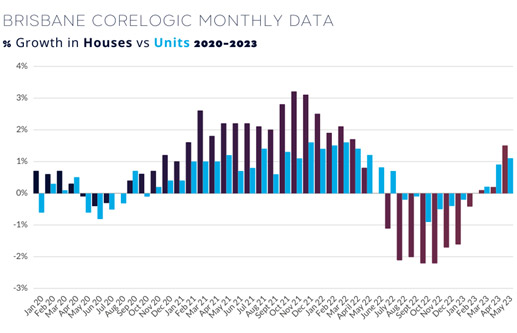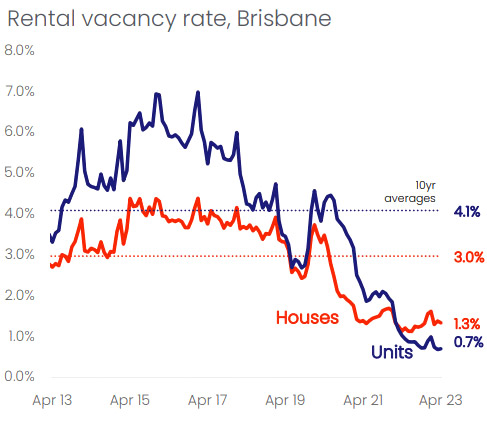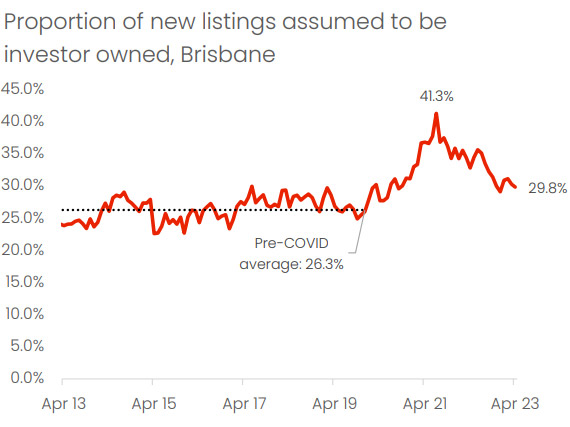Brisbane bounces back with major property price surge
All segments of the Brisbane property market have rebounded strongly, with house price growth now exceeding the unit market.
After two months of very modest dwelling price growth in Brisbane, data released in June data shows a huge spike in property values over a short period of time.
CoreLogic data showed a jump in dwelling values in Brisbane of 1.4 per cent in May. Houses grew 1.5 per cent and units grew 1.1 per cent, which is a big jump from last month and the first month since April 2022 that the housing market has outperformed the unit market in Brisbane.
All segments of the market grew strongly, with a more rapid recovery in property prices being seen in the most expensive quarter of the market.
While it might be a surprise to some, the price surge in Brisbane property values last month has been on the radar for some time.
With very low inventory levels, combined with increasing demand, buyers who may have been looking for a while are starting to act.
Competition has been building for several months and, suddenly, the market conditions have turned once again.
The availability of stock is the biggest concern for buyers in the Brisbane market.
Citywide, the flow of listings in Brisbane is tracking 26 per cent below the previous five-year average according to CoreLogic.
Additionally, for sale stock levels in Brisbane are 39 per cent below average. At the same time housing demand is slightly above the previous five-year trend.
This mismatch between the number of properties available for sale, and the number of buyers in the market is causing an element of FOMO to creep back in for some buyers.
![]()
Some suburbs are demonstrating tighter supply than others, with some of the biggest decreases in new listings on realestate.com.au occurring in Clayfield (-66 per cent year-on-year), Petrie (-63 per cent) and Kangaroo Point (-60 per cent).
At the same time, other suburbs have seen listing volumes increase over the last 12 months.
These locations include Aspley (+150 per cent), Greenbank (+50 per cent) and Jimboomba (+47 per cent).
Local dynamics like this can have an impact on the performance of different segments of the Brisbane property market, so it is always useful to understand that not all Brisbane locations will follow the broader trend.
The competition is also causing days on market to trend lower, meaning properties are starting to sell quickly once again.
It is very common for properties listed by private treaty sale to have multiple offers after the first Saturday open home.
The demand for Brisbane properties is coming from local, interstate and overseas buyers.
Interstate migration is still very strong off the back of the post-Covid boom with southerners looking for a more affordable, warmer and laid-back lifestyle.
Also, according to PropTrack, Brisbane is one of the top five regions within Australia searched by international buyers from United Kingdom, United States, China, Hong Kong, New Zealand and Singapore. With the push for skilled migration, based on real estate search behaviours, it seems Brisbane is a destination of choice for many international migrants.
Apollo Auctions reported auction activity in Brisbane during May increased with an average of 3.9 registered bidders per auction, which was up from 3.5 during April.

Source: CoreLogic
Brisbane rental market remains tight
The rental market across Brisbane remains tight with vacancy rates at 1 per cent for all dwellings throughout the city.
The unit market is tighter than the housing market, with vacancy rates according to CoreLogic sitting at 0.7 per cent and 1.3 per cent respectively.
These are well below the ten-year average vacancy rates for the city, of 4.1 per cent for units and 3 per cent for houses.

Source: CoreLogic
The tightening of vacancy rates in Brisbane has been caused by a combination of a reduction in the supply of rental properties along with heightened demand. More people have been needing rental accommodation off the back of record interstate migration in the post Covid period.
It appears many property investors decided to sell out of the market during the latter months of 2021 and early in 2022, with a higher-than-normal spike in the number of properties assumed to be investment properties hitting that market at that time.
According to CoreLogic, at its peak it was assumed that up to 41.3 per cent of properties being sold were investors offloading.
At the same time the lending data confirmed buyers were largely those looking to purchase their home. The net effect was a reduction in rental property supply.

Source: CoreLogic
Additionally, the number of advertised rental properties in Brisbane is almost 40 per cent below the previous five-year average.
This is further confirmation that the supply of rental properties is supressed, at a time when more and more people are relocating to Brisbane and needing a place to call home.
As a result, rents are still increasing.
Rental price growth is higher in the unit market compared to the housing market.
Unit rents have grown 16.4 per cent in Brisbane over the last 12 months and this growth still appears to be close to the peak rate of growth.
House rents have grown 9.4 per cent over the last 12 months, however the growth in rents in this segment of the market now appears to be slowing down month-to-month, perhaps due to some areas reaching affordability constraints.
Buyer confidence returning
On the ground, buyers appear to have regained confidence, especially in inner city and middle ring locations.
The market has turned around quickly, but the uncertainty remains regarding the direction of interest rates in the months ahead.
It appears buyer confidence picked up a lot when interest rate rises paused in April, but it is possible that any further hike in interest rates in the months ahead could induce further fear and uncertainty for buyers and consequently impact on confidence.
There is still little evidence of forced selling in Brisbane due to mortgage arrears, however, this is unlikely to be a uniform effect across all locations.
Lower income earning areas are more likely to feel the impact as higher income earners generally have more of a buffer to withstand higher holding costs.
It’s important to note that unemployment remains historically low. This is reassuring given it is less likely that we will see forced selling if people coming off fixed interest rates have a job.
The future still looks stable for Brisbane property, despite the headwinds.
This fundamental mismatch between supply and demand will continue to support price growth in the months ahead.





















